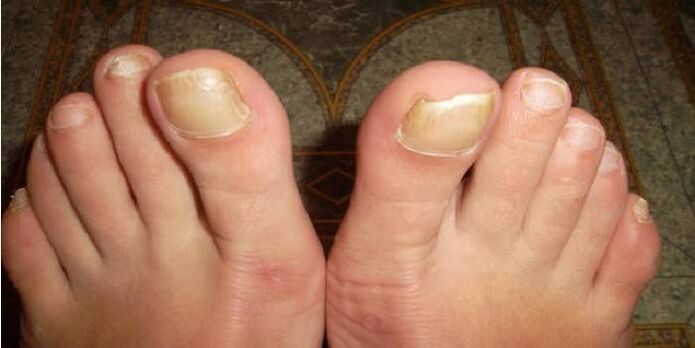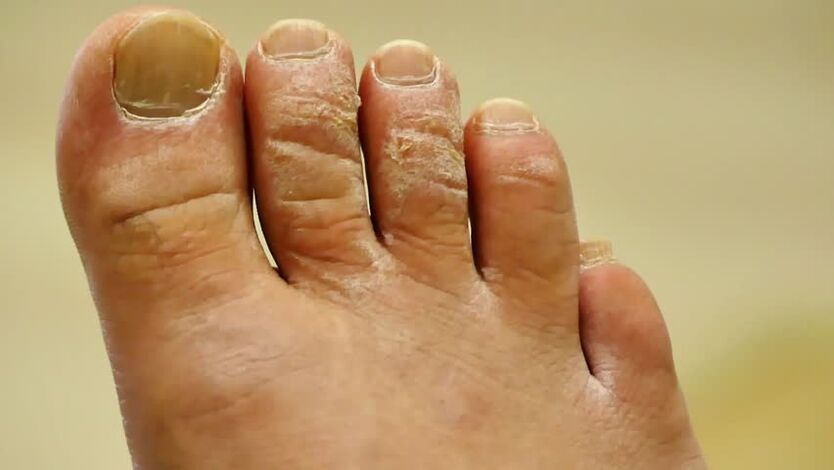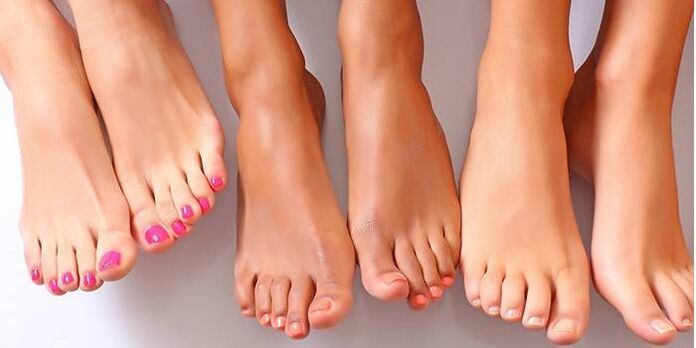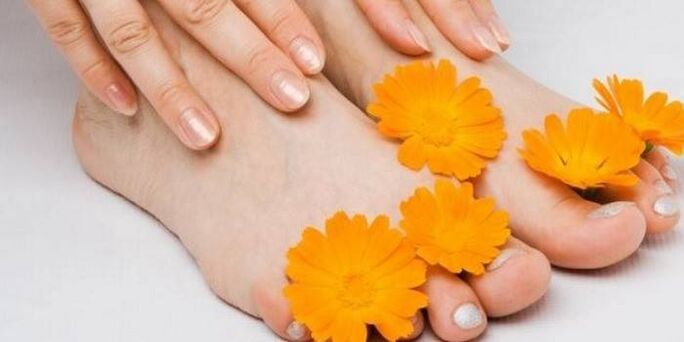Most yeast infections are difficult to treat. Because of this, the effectiveness of therapy against them at an early stage is much higher. In order to cope with the disease faster, you need to know how toenail fungus begins. Often times, a person does not pay attention to the first symptoms, which is a big mistake. In the further course, the fungus not only significantly worsens the quality of life, but also leads to serious complications in the form of a complete loss of the nail plate up to sepsis.
What is athlete's foot
In medicine, a fungus is understood as a group of diseases called mycoses. They rank second after purulent lesions of the epidermis - pyoderma. A pathogenic microorganism parasitizes a person's skin or nails and causes infection. In the first case, the disease is called dermatomycosis, and in the second, onychomycosis. There are other types of fungal infections that are secreted depending on the pathogen. There are many types of mushrooms. They are divided into anthropophilic (concerning humans) and zooanthropophilic (observed in humans and animals).
The reasons
The main risk factor for a yeast infection is a weakened immune system. In this case, the pathogen can enter the body more easily. It is easy to get infected in public places, especially when the humidity and temperature are high, for example, in a swimming pool, gym, sauna, steam room. Risk factors for fungal diseases also include:
- Flat feet;
- insufficient personal hygiene;
- Circulatory disorders in the lower extremities;
- increased sweating;
- frequent trauma to the skin;
- Obesity.
These are common causes of yeast infections. Often times, the causative agent of the disease is itself. Depending on the parasitic fungus, a person can develop the following types of infections:
- Epidermophytosis. It is observed when the skin and nails are attacked by anthropophilic fungi with dermatophytes (Dermatomycetes) of three types: Trichophyton, Microsporum, Epidermophyton. You can get this infection through household items. The risk group includes men of mature age, especially those with excessive leg sweating.
- Trichophytosis. It is caused by Trichophyton fungi, which are particularly contagious. Trichophytosis is also seen in children and adolescents. Workers in showers, baths, and hot workshops are more susceptible.
- Candidiasis. It is seen less often than other forms of the fungal infection. Yeasts of the genus Candida are considered conditionally pathogenic, as they are activated when immunity is weakened.
- Rubromycosis. This is a type of ringworm caused by the fungus Trichophyton rubrum. Due to the high enzymatic activity, the pathogen damages the skin of the feet in large skin folds. Fluffy and long hair is less likely to be affected. Rubromycosis accounts for 60-80% of all fungal infections of the feet.
- Onychomycosis of the feet. This is a fungal disease of the nail plates caused by several types of pathogenic fungi. One or more nails are affected. If the infection is not treated, the plates will be completely destroyed.

Routes of infection
Children are more likely to be infected because their thin skin makes them more susceptible to microorganisms. Risk factors include a weakened immune system, problems with the nervous or endocrine system, the presence of chronic illnesses and changes in the composition of sweat. There are several ways you can get a yeast infection. They fall into two main groups:
- Just. Infection occurs through plants, soil, contact with a sick person or an animal.
- Indirectly. In this case, you can become infected by using personal items belonging to an infected person or whoever used them.
Symptoms of a fungus on the feet
A well-studied clinical picture of fungal infections helps to identify them at an early stage. Damage to the nail and soft tissue structures are visible to the naked eye at the lesion site. Common fungal symptoms are reflected in the list below:
- Discoloration of the nail plate to light yellow at an early stage, and then to yellow, brown, light green, and even black;
- Itching in the periungual zone;
- unpleasant smell;
- Hyperkeratosis, d. H. Thickening of the nail plate or its thinning;
- deformation of the free edge of the nail;
- Peeling of the skin around the nail plate and in the interdigital spaces;
- Calluses and calluses on the foot;
- fragility of the nail, its crumbling;
- Reddening of the skin around the nail plate.
Epidermophytosis and trichophytosis
These forms of fungal infections are almost the same, which is why they have been grouped together. They are called "foot mycoses". Depending on the form, the infection manifests itself in different symptoms. Often a patient has combined several types of fungus at the same time. For this reason, the fungus is divided into forms:
- scaly or scaly;
- dyshidrotic, which is accompanied by a disorder of the sweat glands;
- intertrig, in which diaper rash is noted on the skin;
- hypertrophic, atrophic, or normotrophic onychomycosis.
Squamous cell carcinoma of the athlete's foot
The initial stage of the fungus on the legs of this form is characterized by the defeat of only one foot. The infection does not pass to another until later. The disease can be recognized by the following signs:
- the appearance of a reddened area on the skin of the foot;
- in the future this area will begin to peel off (the affected areas may have another area);
- some patients experience itching.
The difficulty with diagnosing and treating squamous cell carcinoma is that many patients are not concerned about symptoms. For this reason, at the advanced stage, they go to the doctor. If the squamous form of the fungal infection persists, it can take on a dyshidrotic appearance. These two forms are related, so they often provoke the other's appearance.

Dyshidrotic form
This form is characterized by a course with changed remission times and relapses. The very first symptom is the appearance of blisters on the arch of the foot (more common) - where it does not come into contact with the floor while walking. Their size varies from 2 to 8 mm. Gradually they begin to merge and merge into one big one. In addition, each bubble is opened, and in its place a superficial skin lesion remains - erosion.
In addition to the arch of the foot, its inner and outer side surfaces can also become infected. In the place of ulceration of the vesicles, a large erosion remains, combined with diaper rash. The patient also complains of the following symptoms:
- Pain and itching at the site of the lesion;
- after the erosion dries up, it begins to peel off, which leads to the development of a squamous epithelial shape;
- gradually bacterial infection joins, as a result of which the contents of the vesicles become cloudy, purulent (in this case it is necessary to take antibiotics);
- at the next stage, the skin of the foot turns red, swells, the patient has severe pain and even a fever.
Intertrigue form
It is the most common of all forms of trichophytosis and epidermophytosis. It develops alone or against the background of a type of squamous cell fungus. It is celebrated more often in the summer season. There is a remission phase in winter. The disease is long-term and chronic. The beginning of the process can be seen between 4 and 5 toes, less often between 3 and 4. The first signs of an inter-religious form:
- Cracks and maceration in the skin with a whitish edge formed by the peeling epidermis (surface layer of the skin);
- Itching and burning at the site of the lesion;
- Crying in the interdigital space;
- the appearance of erosion cracks, accompanied by a severe pain syndrome.
As the disease progresses, the skin loses its protective function. This increases the risk of developing a strep infection. It manifests itself as a pustular inflammation, which is accompanied by swelling, redness and pain on the skin. Against this background, an increase in body temperature is observed. The patient complains of a general deterioration in well-being.
Onychomycosis of the feet
This disease affects 3 and 4 toes in 70-75% of cases, less often - 1 and 5. Often, onychomycosis proceeds in the form of a normotrophic form, in which the color of the nail changes to yellow and its integrity is preserved. When infected with mold, the infection develops against the background of other diseases. the nail turns yellow, brown, or black.
By means of spots and yellow stripes on the nail plate, it is possible to detect onychomycosis at an early stage. Pathological changes are first observed near its free edge. Depending on the form of onychomycosis, it manifests itself in the following symptoms:
- Hypertrophic. It is accompanied by thickening and yellowing of the nail plate. It crumbles easily, and the skin beneath it begins to peel off, becomes thick.
- Atrophic. The nail plate, on the other hand, becomes thinner. There is also rough skin underneath.

Treatment of the initial stage of the fungus on the feet
In the early stages of infection, topical preparations are used in the form of ointments, gels, patches, solutions, varnishes, sprays and liquids. They are effective by acting directly on the site of inflammation. Gel and suspension are more suitable for the interdigital spaces and an ointment for the heel skin. The initial stage of toenail fungus is treated with antifungal varnishes and solutions.
When the disease has advanced to an advanced stage, systemic medication is required. They are used as tablets and capsules. They destroy the infection from within. In the early stages, the use of tablets and capsules is irrational due to the greater number of side effects compared to local means. In addition to medication, it is important to adhere to the rules of hygiene. This must be done as follows:
- wear closed slippers, do not go home barefoot;
- Treat shoes with special disinfectants 2 times a day;
- wash the patient's clothes separately from everything else;
- wash your feet daily, then treat them with antifungal drugs.
- wet clean and ventilate the room every day;
- rinse it thoroughly with hot water after bathing;
- Change socks daily;
- After recovery, throw away the patient's socks, towels, shoes, washcloths, and other items.
To prevent possible relapses of the disease, it is necessary to strengthen the immune system. To do this, the patient is prescribed immunomodulators and vitamins. The basis of both external and systemic therapy are antifungal drugs. When attaching a bacterial infection, antibacterial drugs are used. Sometimes antihistamines are prescribed to help relieve allergies.
Athlete's foot medication
If you know what nail fungus looks like in the early stages, you can notice it much earlier. This ensures a faster recovery. The effectiveness of therapy also depends on the right drug. There are many antifungal drugs in the form of tablets, ointments, gels. In order to properly use drugs, you need to study their main features:
| Active substance | Mechanism of action |
Type of application, effect |
One treatment |
Contraindications |
Naftifine hydrochloride |
Destroys the pathogens causing mycosis of the feet, some bacteria. Has anti-inflammatory effects. |
Rub the cream or solution into cleansed skin 2 times a day. |
2-4 weeks. |
Pregnancy, breastfeeding, age up to 18 years. |
Natamycin |
Effective against all pathogens causing mycosis of the feet. |
Apply the suspension or cream to the affected skin several times a day. |
Determined by a doctor. |
Sensitivity to the components of the product. |
Clotrimazole |
Many other antifungal drugs have been synthesized based on this substance. Clotrimazole has a wide spectrum of activity. |
Apply to clean, dry skin 2-3 times a day. |
1-4 weeks + 3 more weeks after recovery. |
Hypersensitivity to clotrimazole. |
Econazole |
It is effective against many mycoses, including mold and yeast-like fungi. |
Apply cream, lotion, solution or aerosol to the skin of the feet 1-3 times a day. |
2-4 weeks. |
Pregnancy. |
Itraconazole |
Broad spectrum of activity against all fungal pathogens. |
2 capsules 2 times a day - with onychomycosis; 0. 1-0. 2 g 2 times a day - with mycosis of the feet. |
7 days, then 3 weeks break - in onychomycosis; 1-2 weeks - with mycosis of the feet. |
Pregnancy, breastfeeding, simultaneous use with midozolam, nisoldipine, ergot alkaloids. |
Sertaconazole |
Fungistatic and fungicidal action against Candida fungi and Trichophyton. |
Apply a small amount of cream to the affected area twice a day. |
Up to 4 weeks. |
Pregnancy, breastfeeding, hypersensitivity, childhood. |
Terbinafine |
Destroys pathogens of candidiasis, trichophytos, emdermophytos. |
0. 25 g 1-2 times a day. |
6 weeks, if the nail plates are damaged - 12 weeks. |
Kidney and liver dysfunction, malignant neoplasms, pregnancy, lactation, vascular diseases of the legs. |
Fluconazole |
High activity against yeasts. |
150 mg every week or 50 mg daily. |
6 weeks. |
Pregnancy, breastfeeding, childhood. |
Griseofulvin |
Fungistatic effect against pathogenic fungi. |
16 mg per 1 kg of body weight daily for the first month of treatment; continue in the same dosage, but every other day; in the third month according to the second scheme, until healthy nails grow back. Do not apply the ointment more than 30 g per day. |
For tablets - 3 months, for ointments - 3 weeks. |
Liver and kidney dysfunction, decrease in the number of leukocytes in the blood, pregnancy, lactation, malignant tumors. |

Folk methods
Effective treatment at the early stages of a fungal infection is not possible without medication. They are the mainstay of therapy. Traditional methods are only used as an auxiliary method. Although alternative medicine is relatively safe, you should consult your doctor before using it. He will make recommendations on the following alternative methods of treating a fungal infection:
- Take an equal amount of oak bark, verbena, marigold inflorescences, dried blackberries. From the resulting mixture, pour 3 tablespoons into a separate container. l. Pour a glass of water and light it. Strain after 15-20 minutes, allow to cool to an acceptable temperature. Use to lubricate damaged areas.
- Mix equal proportions of copper sulfate, yellow sulfur and pork fat. After obtaining a homogeneous mass, bring to a boil, and then store in a dark place. After cooling, use to lubricate the affected areas. Pre-steam your feet in a soda bath.
- For 2-3 liters of boiling water, take 2-3 tbsp. l. fresh milkweed. Put the ingredients in a glass container, wrap a blanket and leave for 3-4 hours. Then use for a bath. Pour the broth in a bowl, put your feet in it and soak in the solution for 40-45 minutes. Repeat the process at intervals of 2-3 days until full recovery.
























